Kurosawa Akira and Katsu Shintaro
“Kagemusha” & “Ran”
Released in 1980, director Kurosawa Akira’s film Kagemusha won the Palme d’Or at the Cannes Film Festival. Previously considered to have been suffering from a slump, the film marked a definite return for the “Master.” By the same token, however, the movie also became known for the surrounding scandal of Katsu Shintaro stepping down from the leading role he was originally supposed to be playing. Nakadai—having close relationships with both Kurosawa and Katsu—found himself in a difficult position having to suddenly “stand in” for Katsu.
In this chapter, Nakadai talks about his friendship with Katsu, and his relationship with Kurosawa since Kagemusha.
The Good Old Days With Katsu Shintaro
Actor Utsui Ken was a close friend as well as generation-mate of Nakadai at the Haiyuza Training School. Utsui also happened to be childhood friends with Katsu Shintaro, and it was through him that Nakadai and Katsu first met at a young age.
I first met Katsu when I was still just attending the Haiyuza Training School. Up until that point I’d done four years of night schooling for high school, and in the daytime I worked there as the school office boy. But then at the training school the lectures were always during the day, just like with your regular university. This meant that I had to start working nights instead. So, I’d be working part-time at cabaret clubs, bars, or late-night coffee shops.
So this one time I was working at the bar, and my classmate from the training school, Utsui Ken, brought over this very pale, handsome guy. He said, “Meet my friend. He’s the son of Kineya Katsutoji.” That’s how he first introduced me to Katsu, who was incidentally not yet an actor. He was a shamisen player at the time.
Having formed this connection, after Nakadai and Katsu co-starred in Hitokiri, Nakadai then appeared in the twenty-first installment of the Zatoichi series which could be considered synonymous with Katsu. Zatoichi Goes to the Fire Festival (1970) features Nakadai in the destined-to-die guest starring role of the ronin.
Katsu personally asked me to do it, and so I did. “Wanna give a shot at Zatoichi?” “Sure, why not?” That’s how close our friendship was. Zatoichi really was all about Katsu—his show-offy acting is what makes Zatoichi what it is.
In any case, Katsu was so much fun whenever you got him started on the topic of acting. That man… You could see that he truly loved acting.
How do I explain this… Even when we were drinking together, it was never just drinking—it would always turn into acting debate. We’d start talking about our respective movie scenes of the past. “You know, Moya, in that one scene, you shouldn’t have played it like that. You should’ve played it more like this, don’t you think?” Sometimes, I’d agree with him. “Huh, when you put it that way, you’re actually right.” Other times, I would retort in kind. “Well, I think you shouldn’t have bared the whites of your eyes in that one scene!”
And all the while we were blabbering, we’d have a couple of maiko or geisha just quietly sitting there by our side, listening to our nonsense. That’s what our relationship was like. Even though we had two completely different approaches to acting, we just got along so great as two fellow actors.
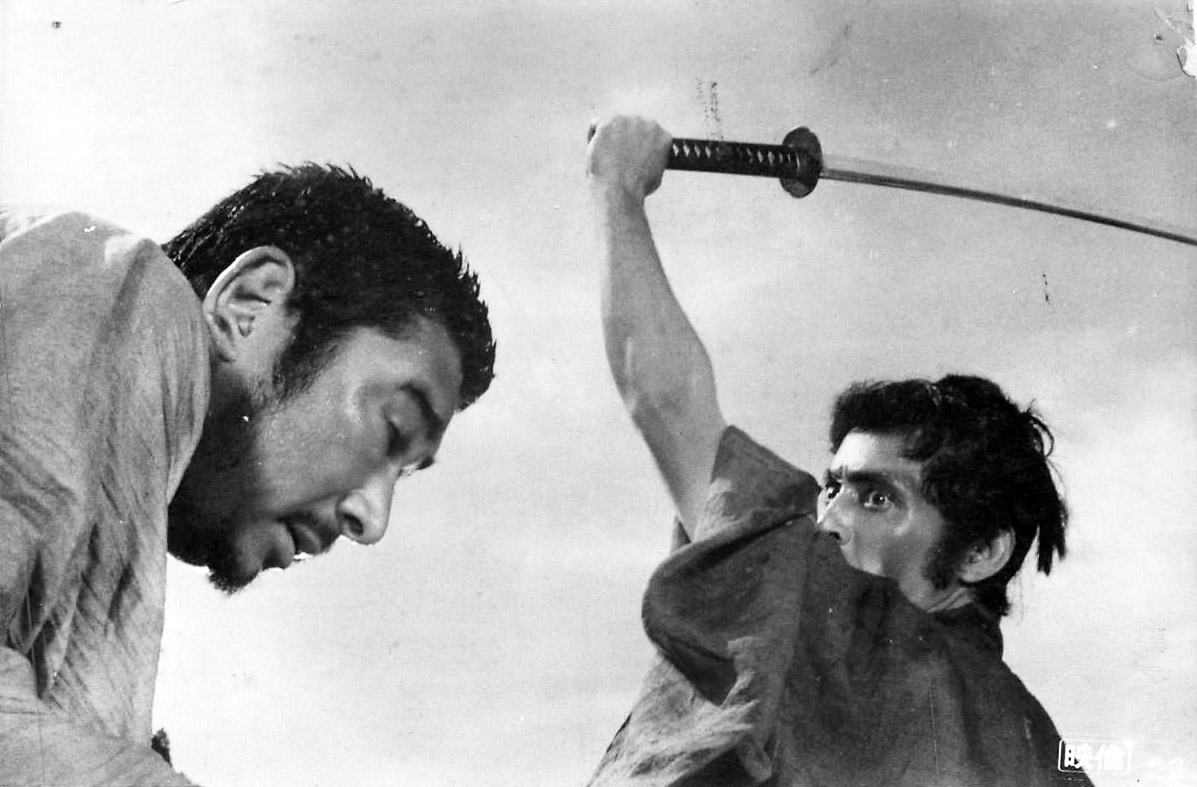
Katsu Shintaro and Nakadai in “Zatoichi Goes to the Fire Festival”
The only trouble with it was the nightly drinking. This one time I was going to start filming at 9 the next morning… But the problem when it came to drinking with Katsu was how you would often be out drinking until 3 or 4 in the morning. So what I did is, I snuck out of the film studio by myself while Katsu was still doing his scenes, and I went out for a couple of drinks by myself. When Katsu found out I had left, he apparently went, “Where the hell is Nakadai?!” as he sent his apprentices searching for me all around the bars in Gion. And they actually caught me!
Katsu himself was not a morning person. Let’s say we were to start shooting at 9. I’d get there to the film studio at 8 since it was a period drama and I’d have to spend an hour in make-up. And yet no matter how long we waited, “Zatoichi” himself just wasn’t showing up. He finally came in around noon, going, “Oh dear, oh dear! Sorry, everyone!”
Maybe if it was just that once, then sure, okay. But then it also happened the next day, and the day after that. So I sort of took him aside where no one could see, and I got angry with him. “Look, I’m gonna go home. I’m leaving this project. You’re the one who got me to come all this way out here from Tokyo. I’m your guest, right? Why is it that I, as the guest, have to sit here waiting around from 9 in the morning, and for the last three days you only show up at noon? It’s because you’ve been drinking ’til morning, right? And sure, it’s your right to do that. But if we start at 9, then we start at 9. If you can’t even get here on time, then I’m leaving!”
He was pulling on my sleeve, saying he was sorry. We’d shot a good number of scenes by that point—I suppose he would’ve been quite inconvenienced had I just up and left. So I made him promise that he’d start showing up at 9 from then on. And to his credit, he actually did.
Around the time of Conflagration, Raizo was a little bit above Katsu in terms of their “stardom rank.” Those two were actually in competition with each other. Raizo would invite people out for drinks, taking all of us Tokyo actors with him to Gion. Meanwhile, Katsu would be out drinking with his group at some other nearby establishment—he was known as the ”General of Gion.” At Raizo’s party, there might be 30 or so of us. So then the next day at the film studio, people would be gossiping about which of the two had hired more geisha or maiko girls for their party. If the general consensus was, “Raizo had two girls more than Katsu!,” then the next day Katsu would have called for something like ten geisha more than last time.
That’s obviously a good way to get yourself into some debt, fast. It was just this weird hang-up that’s very characteristic of the actor world.
“Inn of Evil”
While the 50s ushered in the Golden Age of Japanese Film, by the 60s there were already gradually less and less people going to the movies. In 1969, by which point the Japanese film industry found itself in a slump, directors Kobayashi Masaki, Kurosawa Akira, Ichikawa Kon, and Kinoshita Keisuke formed the “Yonki no Kai” (or “The Four Horsemen”), feeling that they had to breathe some new life into the film world.
In 1971, they produced Inn of Evil. Nakadai plays the leading role, with the screenplay written by his wife, Ryu Tomoe (Miyazaki Kyoko). Katsu also appears in a supporting role.
The first project by Yonki no Kai was a film called Inn of Evil for which my wife wrote the screenplay. It was based on a novel by Yamamoto Shugoro called Fukagawa Anrakutei, but it was when Yonki no Kai read my wife’s script that they decided it would make for something interesting.
While he appears only in a supporting role, we got Katsu to be in it as well. I’d co-starred with him in things like Zatoichi, and Hitokiri before that, so we’d already done quite a bit of work together. When it was time to do Inn of Evil, I just thought to myself how the role had to go to Katsu. Director Kobayashi agreed.
Katsu said he’d be happy to do it, but added: “You have to let Nagata know first. I need his permission.” Back then there was something called the “Five-Company Agreement.” What it meant was that actors attached to a film company could not appear in films by any of the other companies. Inn of Evil was a Toho film while Katsu was attached to Daiei, and thus we had to ask permission from Daiei’s president, Nagata Masaichi. And so, me and the producer headed to their head offices in Ginza.
We were made to wait in this room. However, despite waiting the whole day, Nagata never showed up. We then went back on a different day, and still there was no sign of him. Finally, on the third day, he came. He asked what we wanted, and we told him. “Actually, you see, Yonki no Kai are making this film called Inn of Evil. It’s an adaptation of a Yamamoto Shugoro novel called Fukagawa Anrakutei, and we were really hoping to use Katsu for a role. Could you please, please somehow allow us to have him?”
His answer was pretty much just: “Oh, sure!” We got his immediate approval. At the time, Daiei found themselves in the midst of an escalating union dispute—the only reason Nagata hadn’t been showing up at their head office much was because he’d been busy dealing with all of that.
It was the perfect role for Katsu, and I was glad to have him cast in the role. They gave him free reign in the filming of that one.
The Leading Role Change of “Kagemusha”
However, there was trouble between Katsu and Nakadai on the horizon. Katsu, having been cast in director Kurosawa Akira’s epic Kagemusha, he came into conflict with the director, leading him to quit midway during filming. His replacement ended up being none other than Nakadai. This incident permanently severed their relationship.
Wakayama Tomisaburo, Katsu’s older brother, was originally meant to appear in Kagemusha as Shingen, while the role of the thief who becomes his body double was to be played by Katsu. When I first heard of this I thought, “Oh, now this is interesting!” The two looked so much alike. But then Wakayama turned down the project, saying, “Kurosawa Akira? No way am I going to work with a finicky director like him!” And so, Katsu was set to play both roles.
I saw Katsu at a party before they started filming. He went, “Hey, Moya! I’m going to be doing a Kurosawa film soon. Any advice? Anything to look out for over there?” By this stage, he was both playing and directing Zatoichi by himself. I told him, “You can’t be like that on Kurosawa’s set. When you’re on his set—and this is true for me, too—you need to do exactly as he tells you. If you don’t, it’s never going to work out.” So he said, “Oh? Well, in that case, that’s what I’ll do.” We said our goodbyes, and I thought to myself, “Okay, good. I’m sure everything will go smoothly.”
With Kurosawa’s projects, they’d start preparing around two months prior to starting filming. Then, they’d have about a month of rehearsals. However, Katsu apparently wasn’t showing up at said rehearsals. Kurosawa’s script supervisor, Nogami Teruyo, came to me for advice. “You’re friends with Katsu, right? Why isn’t he coming to our rehearsals?” Katsu’s take on it was: “I’m not the rehearsing kind of actor. I’m someone who ad-libs and performs in the moment.” And I had just been telling him how that was exactly the kind of thing that wouldn’t fly with Kurosawa…!
I reckon that is what must have led to Kurosawa’s decision.
When they issued the first press release about the film, they only had a suit of armor in place of where Katsu was supposed to be sitting. They had Yamazaki Tsutomu and everyone else there in the picture, but Katsu’s spot was occupied by nothing but the armor. When I saw that, I thought… “Oh no. You’ve really gone and done it now, Katsu.”
It must have been… Maybe a week later. Kurosawa asked me, “Hey Nakadai, what are you up to right now?” I was working on another project at the time. He then asked me, “How much longer until you’re finished with that project?” You can bet I was thinking, “Am I really going to be stepping in for Katsu…?”
So I told Kurosawa. “Katsu is a friend. I’m going to talk to him about it. I’ll talk to him, and if he says it’s OK, then I’ll do it.” But no matter how many times I called and tried to reach him in other ways, I just couldn’t get ahold of him. Looking back on it now, it’s no wonder. Thinking about it from his standpoint, it’s not like he could’ve just said, “Sure, go ahead and do it, Moya.” Nor could he have said, “Don’t do it, Moya.” I think Katsu’s ignoring me was his way of taking my feelings into consideration.
Ultimately, however, I found myself at a press conference surrounded by swathes of reporters, and I announced myself as Katsu’s replacement without ever getting the chance to talk to him about it beforehand. They asked me, “How do you feel about being his stand-in?” I answered, “I don’t think of it as being his stand-in.”
Casting is the most difficult part about making a movie. Say you have actor “A” in mind, but then it turns out you can’t use them so you have to use actor “B” instead. That kind of thing happens all the time with movies everywhere in the world. Even personally, I’m aware of many such instances. If your first choice doesn’t work out, you go for your second choice, or your third choice. And so I told the reporters: “Actors from all over the world wish they could appear in a Kurosawa film. That’s a fact. So even if I was only the director’s second choice, I’m very much happy to do it. I’m not going to dwell on Katsu. I gratefully accept the offer.”
And wouldn’t you know it, the next morning the sports papers were filled with: “HAPPY TO DO IT!” “HAPPY TO DO IT!” Those were the headlines. “ACTOR WITH NO HONOR OR HUMANITY!” It was tough, dealing with the aftermath of all that. I received quite a number of threatening phone calls as a result.
I lost all contact with Katsu because of this, even though we had always been friends up until that point. Then, in 1996 when my wife passed away, Katsu suddenly showed up at the funeral without any prior notice. He offered some incense, said, “I’m sorry for your loss,” and we shook hands. He showed no lingering feelings as to Kagemusha, nor did he even mention it. He said to me, “You’ve got to hang in there even without your wife,” and we embraced, saying our goodbyes. The following year, Katsu himself passed away.
When one has been acting for 60 years, there’s bound to have been all sorts of mishaps along the way. But even so, all our collaboration… My friendship with Katsu… Ending in the manner that it did… In a sense, it was more “dramatic” than any movie I’ve ever seen.

Nakadai and Katsu Shintaro in “Hitokiri”
The Difficult Filming of “Kagemusha”
Taking Katsu’s place in Kagemusha, Nakadai played two roles: those of Takeda Shingen, and the thief who becomes his body double, or kagemusha. Having stepped in midway through production, even a great actor of his caliber struggled on set.
The most difficult thing was that first scene. I played the roles of Shingen and the thief, and to my side there was Yamazaki Tsutomu playing Shingen’s younger brother, Nobukado. When shooting that scene, I first came out as Shingen. Yamazaki was there, too, and the thief was played by a stand-in. We shot the entire scene like that. Then we cut, I quickly switched gears and became the thief, and went to sit exactly where the stand-in had just been sitting. Likewise, the same stand-in sat where I had just been sitting as Shingen. Once we were done, they physically cut off all the parts of the film where the stand-in was visible. That’s how we shot that scene.
That was nearly a 10-minute scene. Obviously, you can’t do a scene like that like it’s nothing. We spent around half a month rehearsing it. Every day I would wear my kimono, do my make-up, and there in the training room on the highest floor of the Actor’s Hall, Yamazaki, me, and the stand-in spent half a month—maybe about twenty days—practicing it. Every single day, wearing full make-up and all the rest of it.
But then Kurosawa says to me, “Your face is different from Katsu’s.” Well, I would sure think so! But then he actually ordered me to make myself look more like him. So, I would go to the dentist’s every day to have them fit my teeth with these wads of cotton which would make my cheeks swollen. On the flip side, however, that also caused my teeth to get worse later on…
I suppose Katsu had a round face whereas I had a bit of a sharper face. But Kurosawa was saying, “That’s just not going to cut it, Nakadai.” Well, what do you expect me to do?! It’s my face! Sure, foreign movie stars like De Niro can go to Europe for half a year, eat nothing but delicious food, and easily gain 20 or 30 kilos. But we weren’t afforded that sort of time.
In Japan’s Tragedy, a film by director Kobayashi Masahiro, I played a character dying of lung cancer. I had to lose about 10 kilos for that role. Having to go on diets even in your eighties—goodness, what a line of work I find myself in!
Getting back to the topic of Kagemusha, that role was never envisioned with me specifically in mind. There was this painter called Hasegawa Tohaku, and he made a portrait of Shingen. It’s such a great painting, too—Shingen’s face is like a perfect circle. Setting out to find actors with such perfectly round faces, Kurosawa found two brothers: Wakayama Tomisaburo and Katsu. And so Wakayama was cast as Shingen and Katsu as the thief… And they both left the project.
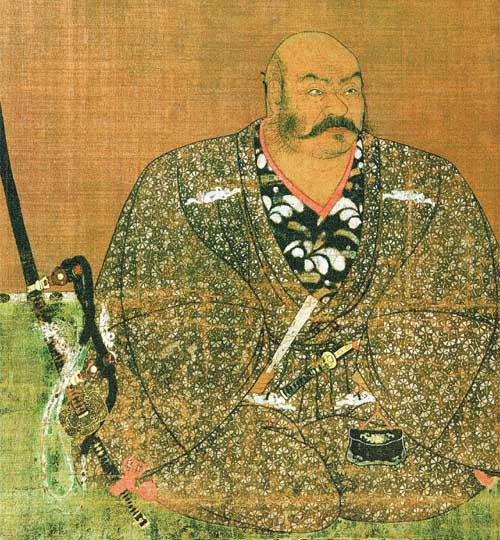
Hasegawa Tohaku’s portrait of Takeda Shingen
So when I said I would appear in the film, I asked Kurosawa to adjust the script. “It’s a different actor doing the role now. Please change the character accordingly!” But he just said, “I can’t do that. We’ve already begun shooting.”
The thing about this film is how it’s actually the thief—rather than Shingen—who is more interesting as a character. Shingen is the imposing, silent type. The thief, very comical in nature, is always moving around. However, Kurosawa specifically told me that he very much didn’t want anything comical in regards to my acting. Knowing how skilled Katsu was at comedy, if he had ended up doing the role of the thief, I’m sure he would’ve portrayed it in a comical way. But that’s not what Kurosawa wanted.
From Kurosawa’s perspective, the movie was all about Shingen. The thief was not meant to stand out. “It’s a story about how even the thief and all of Shingen’s retainers end up giving their lives for the sake of his personal virtue.” Thus, the thief was not to encroach on Shingen, and I played the role in a reserved manner.
And yet, people who had seen me playing the role of the thief were going, “I bet Katsu would’ve been funnier in that role.” I just wanted to tell them, “But you people haven’t seen Katsu’s version of it.” I didn’t much care to be compared against something that existed only in their imaginations. Because the fact of the matter is: I’m the only person who did play the role of the kagemusha.
Yamazaki Tsutomu
Yamazaki Tsutomu plays Shingen’s younger brother, Nobukado. It was the first time since High and Low for the two to be co-starring.
He is a character, that man. He was maybe about four years my junior at the Haiyuza Training School. Such a funny guy. There are so many actors who, when the director tells them to do something—no matter what it is—they just go, “You’ve got it, boss!” I’m personally not really like that, and Yamazaki similarly will always stand up to the director when he feels he needs to. If there’s something he doesn’t want to do, he lets them know. That’s why he might have a bad reputation in some circles. But for me, despite the fact that he’s my junior, I have a lot of respect for him just because I can see how he lives true to himself as an actor.
He was that way when he did Teshigahara’s Rikyu, too, playing the role of Hideyoshi. He had put careful thought into what he believed the person of Hideyoshi to be, but his thoughts ran counter to how the director felt. Nevertheless, he stuck to his beliefs all the way until the film’s completion. It’s that kind of thing that I find admirable about him. Although I must say that when I saw the film, I did ask him, “Hey, don’t you think you went a little overboard with that one?”
He provided me with much support during the making of Kagemusha. Katsu had already been officially cast in the role, so when I suddenly came in as his substitute, it changed the mood among the rest of the cast. That’s only to expected—people looked up to him, and now he was suddenly just gone. In any case, initially it wasn’t a very pleasant atmosphere on set. But during that time, Yamazaki in many ways concerned himself with me. He put great effort into trying to restore the atmosphere on set. Well, they were all my juniors, and eventually the atmosphere did improve.
Here’s another thing that happened during the filming of Kagemusha.
This one time, Kurosawa repeatedly scolded the actors for their nervousness. “Why do you get nervous?! You can’t do anything when you’re that nervous!”
Afterwards, me, Kurosawa, and Yamazaki were drinking. I said, “Director, when you get angry with the actors for being nervous, the only thing that’s going to accomplish is to make them even more nervous.” Kurosawa said, “What? Really?” I said, “Obviously! Listen, I’ve been making films with you since Sanjuro, and you have a reputation for being strict with your actors. But if you tell an actor to not be nervous, that’s only going to make it worse. Right, Yamazaki? That’s what it does!”
Kurosawa, speaking with almost a childlike innocence, said, “Hmm… I see. So that’s what actors are like. All right. Starting tomorrow, I’m going to stop doing that.” I replied, “Yes, I really think you should, director.”
But then the very next day when the actors weren’t acting to his liking, he was again going, “Stop being so nervous!” The set of a Kurosawa film was always an amazing sight to behold. His shouting and screaming, always resounding in the air. The constant barrage of, “You goddamn idiots!” Kurosawa always used to say that the person he most respected was Napoleon. It was that leadership quality of his, I suppose… That man really was like an army general.
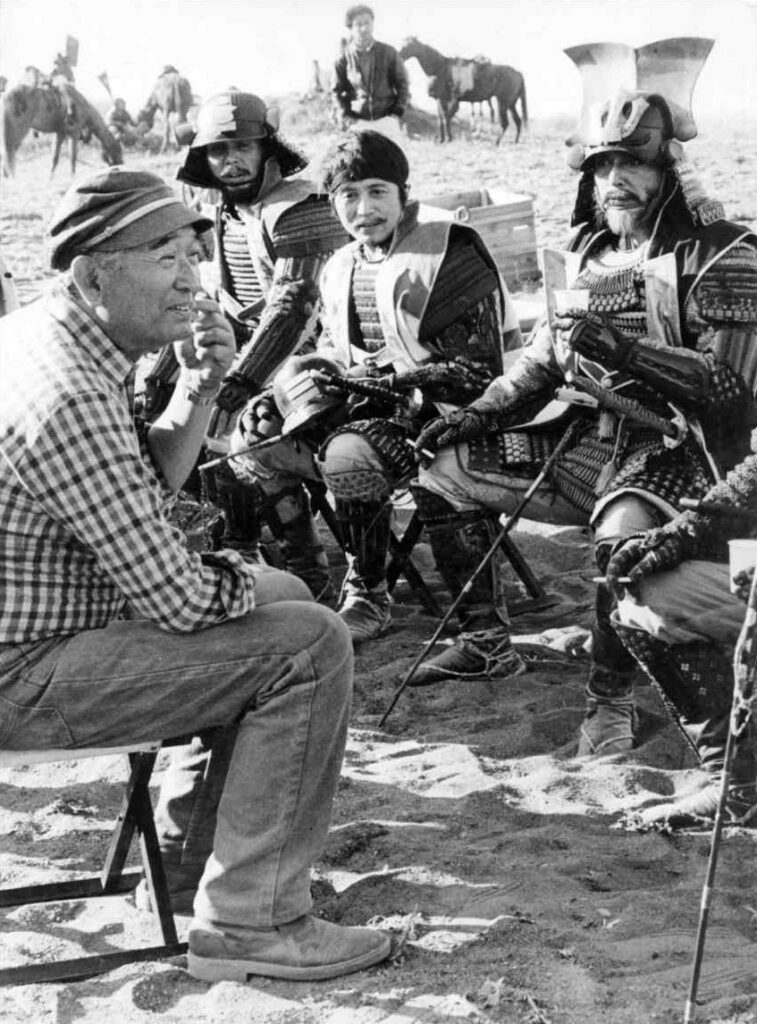
During a break on the set of “Kagemusha”
Director Kurosawa (L), Nakadai (R)
Battle of Nagashino
The climax of Kagemusha depicts the Battle of Nagashino in which Takeda’s cavalry suffers a crushing defeat against Oda’s gunners who had been lying in wait. It is a grand spectacle, with innumerable fallen horses completely covering the ground.
We had 300 horses for that last scene. Now that was difficult. They knew the animal rights organizations wouldn’t like it, so we shot the scene in secrecy. We had to drug the horses to make them collapse, and so we gathered up all the veterinarians in Hokkaido to help. But even having found every last vet in the prefecture, we still only had about 100 of them. They had to administer stabilizer and sleep medication for 300 horses. It was just pandemonium—demonic, even.
The thing about horses is that when they collapse, you’d assume they do so slowly, gradually staggering off to sleep. But that is not the case. When you administer them with stabilizer and then the sleep medicine, they come crashing down. Several people were injured, being squashed under the horses. Even now I shudder when I think back on that week. But by that same token, the scene definitely has the corresponding amount of impact. Something like that had never been done before, and there was no CGI involved. We had about ten ambulances there.
So the horses would collapse, and people were told to act dead beneath them. But let’s say another horse came running by. If it was to kick you in the head… That would be bad news. But Kurosawa insisted. “The horses may move, but all you dead people, you can’t move. The people absolutely can not move.” The whole set went on strike for three days because of that. It’s no wonder people were upset.
At the end, I too had to plunge in there with all the collapsed horses. When I collapsed after being shot, the snoring of all the sleeping horses was so loud, it was like this immense rumble that seemed to arise from within the ground itself. Even then, Kurosawa kept insisting that the people weren’t allowed to move. We spent about a week shooting that. Quite a few horses died in the process, and there were many people with broken bones. I suppose it’s something that could only have ever been accomplished because it was Kurosawa Akira.
Nowadays you have 3D technology that makes it feel like the images are jumping out at you. But even without such technology, it’s possible to create films that feel like they’re somehow “shaking” and coming towards the viewer. Both Kurosawa Akira and Kobayashi Masaki very much had that feel to their movies. In any case, we had 300 horses in Kagemusha, but zero use of CGI.
One time I was in China for a screening of a Kurosawa film, and I was talking about Kagemusha‘s lack of CGI. The director John Woo was there, and he said, “I actually used it a little bit.” He was talking about his film Red Cliff which is based on Records of the Three Kingdoms. And that wasn’t just “a little bit” of CGI either—it was, in fact, quite a bit! In any case, he said, in reference to Kurosawa: “I feel ashamed for having myself used CGI.”
The Monumental Masterpiece:
“Ran”
Thereafter, Nakadai played the leading part in Kurosawa Akira’s next film, Ran. It is an adaptation of Shakespeare’s King Lear, set in Sengoku period Japan. Nakadai played what would be the film’s equivalent of King Lear: the Sengoku warlord “Ichimonji Hidetora.”
It is a role of a man who entrusts his kingdom to his sons only to be attacked by them all in succession, causing him to lose his mind. The stunning scene where his sons have struck his castle and he walks out of his burning castle tower in dumbfounded amazement leaves a lasting impression.
Kurosawa had enormous ability for doing adaptations, and so he also adapted King Lear into Ran. I actually received the script for it before Kagemusha—much earlier, in fact, than even Katsu’s withdrawal from that film. Kurosawa told me it was a movie he very much wished to make.
You know, I believe that certain people are just destined to meet each other. The Kurosawa-Mifune pair was one that I very much loved even before becoming an actor myself—Drunken Angel, Stray Dog, films like that. I felt that they made for a pretty amazing duo. Later on, I myself got to act with Mifune, being chosen for roles where he cuts me down. In any case, the actor-director combination of Mifune and Kurosawa were destined to meet each other and make masterpieces together.
While Kurosawa stopped working with Mifune after Red Beard, I believe he had originally envisioned both Kagemusha and Ran to star him—that pair always continued to live on, even after they parted ways. With Kagemusha, Wakayama turned it down, Katsu was out of the picture, and so it finally came to me. I was thus the fourth choice for the role. Similarly with Ran, my assumption is that the role was originally envisioned for Mifune. That’s why—perhaps to make up for it—I had to wear such extreme make-up for the role.
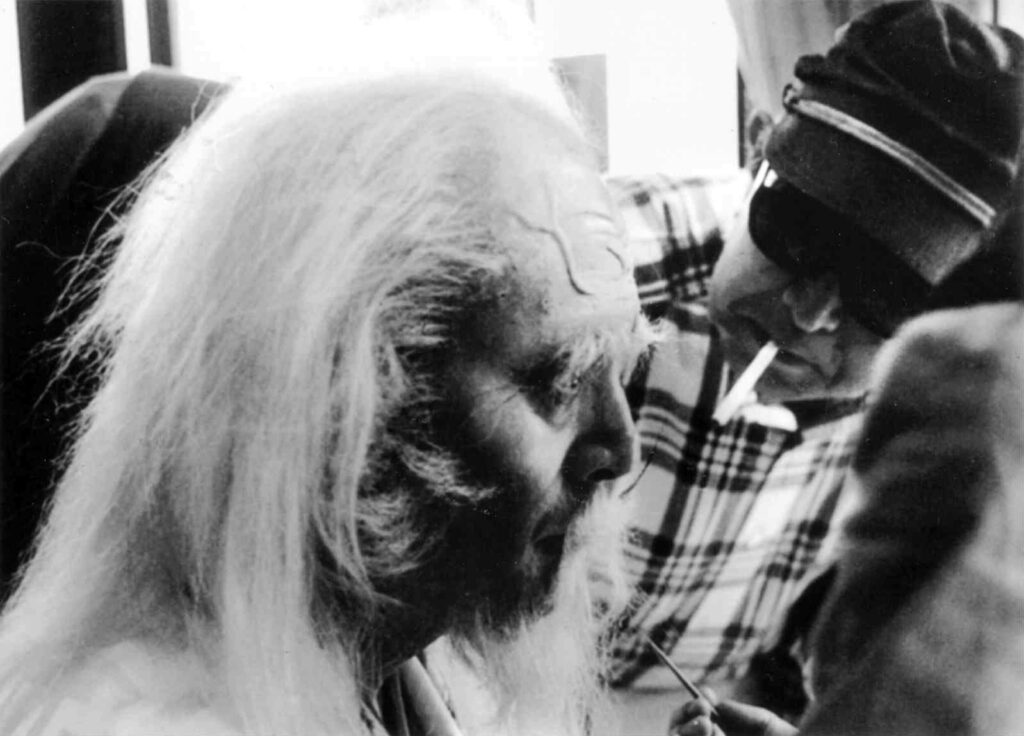
Director Kurosawa checking on Nakadai’s make-up before filming commences on “Ran”
When I first got the script… Well, I had already read King Lear and it was my intention to do the play someday. But then I was reading the script, and there’s this scene where the castle is burning, and I was to descend the stairs and disappear into the wilderness while being filmed by eight cameras… The budget for the castle set alone was to be 500 million yen. The whole script struck me as amazing when I read it. But more than anything else… I simply wanted to do that scene.
In fact, even before I’d read the script, Kurosawa was telling me how he wanted to shoot that scene in one take. Talk about feeling excited! I mean, I was sure the whole thing was going to be amazing. But that one scene in particular…!
Actually shooting the scene, however, was more difficult than I’d ever imagined. As a director, there was no compromise with Kurosawa when it came to his vision of what it was he wanted to create. Moreover, Japanese film productions of the past were given both the time and the money they required, so movies would be made exactly how their creators intended them to be made.
He of course gave the actors the script before we started filming, and it describes that scene of me walking down the exterior stairs of the castle while it is burning. As he was showing me the script, Kurosawa explained: “Nakadai, the stairs will be at a very steep angle. But if you fall, that’s going to be 500 million yen gone to waste.” What’s more, he added: “Your character has gone crazy, so you must not look down when you’re walking. You absolutely must keep your line of sight facing forward.” But I suppose I was feeling cocky at the time. I said, “No problem. I’ve got eyes in my big toes.”
And so we started filming. I was waiting inside the castle, and I was supposed to keep waiting for a bit even after they’d lit up the castle before making my way out and walking down that staircase. I assumed I would at least have an assistant director or someone in there with me, but there was no one—which was only obvious, I suppose, since the entire castle was burning down. So I was just waiting there by myself as the castle kept burning down around me. Still, it’s not like they could have actual burning lumber falling on me or anything of that sort, so I was in this separate waiting room. But even in there, the smoke was just… It was something else.
I then heard Kurosawa’s voice coming from a speaker on the set. “Nakadai, you can come out now!” There were over five meters between where I was waiting on stand-by and where I was supposed to get out, and the scene would’ve been ruined had I tripped. So I walked very, very carefully towards the exit. I could hear a worried Kurosawa on the speaker. “Nakadai?! What’s wrong?!” In my mind I was thinking, “Just calm down, Kurosawa. If I stumble, we’ll have wasted 500 million yen all for nothing.”
Later, Kurosawa told me that in three more seconds he would have stopped the scene prematurely—he was worried I might’ve collapsed. But just then, all that smoke came blowing out and I appeared, proceeding to slowly come down the stairs and disappear off into the wilderness. We managed to get it in one take.
And that’s how we made Ran. I simply wanted nothing more than to do that one scene. I put my life on the stake for that scene. Setagaya Fire Department had sent about ten fire trucks to Toho Studios when we were shooting on set. I had blisters on my face by the time we finished.
There was another thing about Ran that I was very much mindful about, and that was the horseback riding.
While I could already ride a horse despite not having taken any formal lessons, I actually fell off my horse during the filming Kagemusha. I was wearing a helmet, riding towards adverse wind with about 20 horsemen riding behind me. Picking up the pace and riding faster, the wind suddenly caught my armor and I fell off, breaking three ribs. As a result, the filming schedule of Kagemusha had to be delayed by about half a month. I was 45 years old during the filming of Kagemusha. I was 50 during Ran, and I didn’t wish to repeat the mistake of falling off my horse like I had during Kagemusha.
Struggling to find Japanese funding for Ran, Kurosawa used his connections in countries like France and the UK to secure the 3 billion yen budget. While he was getting that money together, we all just kept quietly waiting. I, too, refrained from appearing in any other works in the meantime.
I was practicing my horseback riding every day in preparation. I needed to have my own horse to do so, and so I bought two retired racetrack horses. There was this great man by the name of Watanabe out in Fujinomiya who coached everyone with their horseback riding during all of Kagemusha and Ran, and I received a very thorough education from him. I was commuting to Fujinomiya practically every day for six months. By the end, I could even do hands-free horseback archery.
But then the day before we were to start filming, Kurosawa suddenly went, “Bring over an unsaddled horse!” I’d never ridden an unsaddled horse before. I was whipping the horse to make it run, tightly grasping on to its hair because there were no reins to hang on to. Kurosawa was trying to build up my courage by having me do that. I knew I was just going to end up falling off the horse again during the actual filming though, so they did finally put on the proper horse gear. Still, as a result, I became a considerably proficient horse rider.
That instructor once told me, “Nakadai, listen. Horses weren’t born for the purpose of being ridden by humans. It’s us humans who are in the wrong for forcibly riding them. I take offense at the people who say, “Be careful when you’re behind a horse. They might kick you!” Horses aren’t like people—they can’t easily see behind them. They’d have to rotate those huge bodies of theirs in order to do that, so they’re very cautious about their rear.” Moreover, he would say, “People who eat horse meat deserve the death penalty.” That’s just how much of an affinity he had towards horses.
Kurosawa’s Final Years
Kurosawa subsequently ceased making large-scale movies, and Ran turned out to be his last work with Nakadai.
After that, Kurosawa stopped making so-called large-scale films due to lack of money. He was confined to making smaller works, such as Dreams. Although those kinds of films were also great in their own right.
I went to see Kurosawa at his home on his final birthday. He said, “Nakadai, we should do one more big one.” That was the dream. But alas, it was not meant to be.
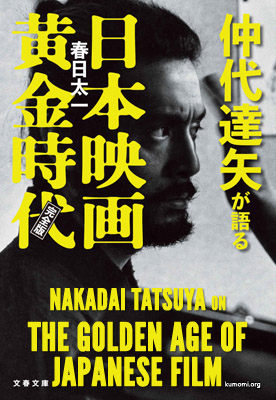
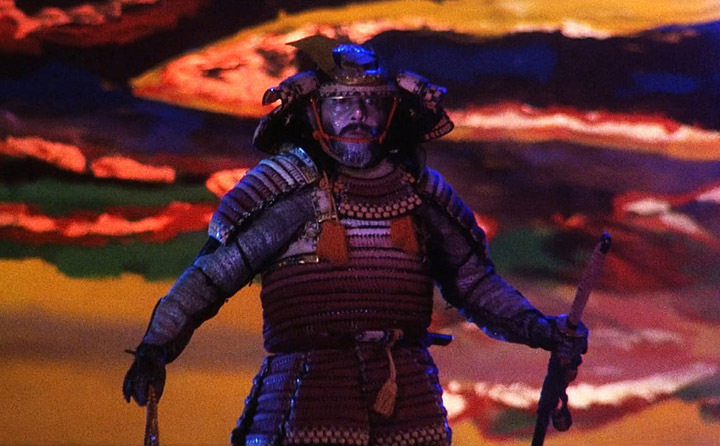

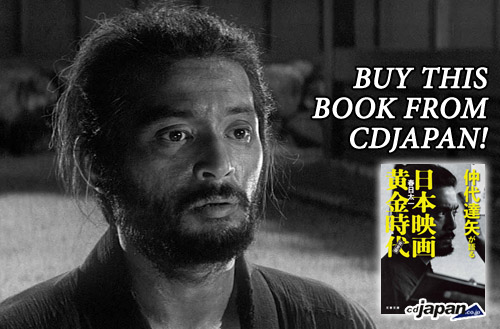

Another great read, thank you!
Great job as usual. Thank you! 🙂
Nice one